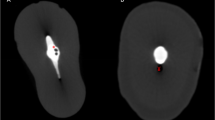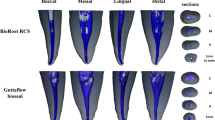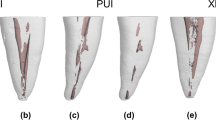Abstract
The present study evaluated the quality of single-cone root canal fillings with bioceramic (BC) sealer using three different techniques by means of micro-computed tomography (micro-CT). The canals of 30 extracted single-rooted permanent teeth were shaped with R40 Reciproc blue files and filled with the single-cone technique (SCT). BioRoot RCS BC sealer was placed inside the canals with one of the following master cones: R40 cone to working length (RWL, n = 10); R40 cone trimmed 1 mm short of working length (RWL-1, n = 10); non-standardized gutta-percha cone to working length (NSWL, n = 10). A quantitative and qualitative micro-CT analysis assessed the filling quality and internal/external voids formation. Collected data underwent statistical analysis by multivariate one-way analysis of variance (α = 0.05). In all groups, the voids were minimal and prevalently external. The NSWL and RWL-1 groups had increased sealer ratios in the whole canal and the apical canal portion, respectively. The lowest amounts of voids were found in the RWL group; the void volumes were slightly greater in the RWL-1 mm and NSWL groups, especially at the apical level. Two alternative SCTs showed satisfactory filling ability, uniform distribution of the BC sealer, and a minimally increased voids formation compared to the standard SCT with dedicated cone. The two tested alternative SCTs could take advantage of the beneficial characteristics of the BC sealer, which evenly filled the endodontic space, ideally sealing both the major and the accessory communications with the periodontium.






Similar content being viewed by others

References
Li GH, Niu LN, Zhang W, Olsen M, De-Deus G, Eid AA, et al. Ability of new obturation materials to improve the seal of the root canal system: a review. Acta Biomater. 2014;10:1050–63.
Kojima K, Inamoto K, Nagamatsu K, Hara A, Nakata K, Morita I, et al. Success rate of endodontic treatment of teeth with vital and nonvital pulps. A meta-analysis. Oral Surg Oral Med Oral Pathol Oral Radio Endod. 2004;97:95–9.
Ng YL, Mann V, Rahbaran S, Lewsey J, Gulabivala K. Outcome of primary root canal treatment: systematic review of the literature—part 2. Influence of clinical factors. Int Endod J. 2008;41:6–31.
Angerame D, De Biasi M, Pecci R, Bedini R, Tommasin E, Marigo L, et al. Analysis of single point and continuous wave of condensation root filling techniques by micro-computed tomography. Ann Ist Super Sanita. 2012;48:35–41.
Somma F, Cretella G, Carotenuto M, Pecci R, Bedini R, De Biasi M, et al. Quality of thermoplasticized and single point root fillings assessed by micro-computed tomography. Int Endod J. 2011;44:362–9.
Mirfendereski M, Roth K, Fan B, Dubrowski A, Carnahan H, Azarpazhooh A, et al. Technique acquisition in the use of two thermoplasticized root filling methods by inexperienced dental students: a microcomputed tomography analysis. J Endod. 2009;35:1512–7.
Schafer E, Schrenker C, Zupanc J, Burklein S. Percentage of gutta-percha filled areas in canals obturated with cross-linked gutta-percha core-carrier systems, single-cone and lateral compaction technique. J Endod. 2016;42:294–8.
Li GH, Niu LN, Selem LC, Eid AA, Bergeron BE, Chen JH, et al. Quality of obturation achieved by an endodontic core-carrier system with crosslinked gutta-percha carrier in single-rooted canals. J Dent. 2014;42:1124–34.
Iglecias EF, Freire LG, de Miranda Candeiro GT, Dos Santos M, Antoniazzi JH, Gavini G. Presence of voids after continuous wave of condensation and single-cone obturation in mandibular molars: a micro-computed tomography analysis. J Endod. 2017;43:638–42.
Celikten B, Uzuntas CF, Orhan AI, Orhan K, Tufenkci P, Kursun S, et al. Evaluation of root canal sealer filling quality using a single-cone technique in oval shaped canals: an in vitro micro-CT study. Scanning. 2016;38:133–40.
Veljovic D, Colic M, Kojic V, Bogdanovic G, Kojic Z, Banjac A, et al. The effect of grain size on the biocompatibility, cell-materials interface, and mechanical properties of microwave-sintered bioceramics. J Biomed Mater Res A. 2012;100:3059–70.
Krell KF, Wefel JS. A calcium phosphate cement root canal sealer—scanning electron microscopic analysis. J Endod. 1984;10:571–6.
Best SM, Porter AE, Thian ES, Huang J. Bioceramics: past, present and for the future. J Eur Ceram Soc. 2008;28:1319–27.
Jefferies SR. Bioactive and biomimetic restorative materials: a comprehensive review. Part I. J Esthet Restor Dent. 2014;26:14–26.
Zhang H, Shen Y, Ruse ND, Haapasalo M. Antibacterial activity of endodontic sealers by modified direct contact test against Enterococcus faecalis. J Endod. 2009;35:1051–5.
Zhang W, Li Z, Peng B. Ex vivo cytotoxicity of a new calcium silicate-based canal filling material. Int Endod J. 2010;43:769–74.
Loushine BA, Bryan TE, Looney SW, Gillen BM, Loushine RJ, Weller RN, et al. Setting properties and cytotoxicity evaluation of a premixed bioceramic root canal sealer. J Endod. 2011;37:673–7.
Gandolfi MG, Iacono F, Agee K, Siboni F, Tay F, Pashley DH, et al. Setting time and expansion in different soaking media of experimental accelerated calcium-silicate cements and ProRoot MTA. Oral Surg Oral Med Oral Pathol Oral Radio Endod. 2009;108:e39–45.
Jeong JW, DeGraft-Johnson A, Dorn SO, Di Fiore PM. Dentinal tubule penetration of a calcium silicate-based root canal sealer with different obturation methods. J Endod. 2017;43:633–7.
Chybowski EA, Glickman GN, Patel Y, Fleury A, Solomon E, He J. Clinical outcome of non-surgical root canal treatment using a single-cone technique with Endosequence bioceramic sealer: a retrospective analysis. J Endod. 2018;44:941–5.
Kahn FH, Rosenberg PA, Schertzer L, Korthals G, Nguyen PN. An in-vitro evaluation of sealer placement methods. Int Endod J. 1997;30:181–6.
Branstetter J, von Fraunhofer JA. The physical properties and sealing action of endodontic sealer cements: a review of the literature. J Endod. 1982;8:312–6.
Wu MK, Wesselink PR. Endodontic leakage studies reconsidered. Part I. Methodology, application and relevance. Int Endod J. 1993;26:37–43.
Spradling PM, Senia ES. The relative sealing ability of paste-type filling materials. J Endod. 1982;8:543–9.
Spangberg LS, Acierno TG, Yongbum Cha B. Influence of entrapped air on the accuracy of leakage studies using dye penetration methods. J Endod. 1989;15:548–51.
Jung M, Lommel D, Klimek J. The imaging of root canal obturation using micro-CT. Int Endod J. 2005;38:617–26.
Zhao D, Shen Y, Peng B, Haapasalo M. Micro-computed tomography evaluation of the preparation of mesiobuccal root canals in maxillary first molars with Hyflex CM, Twisted Files, and K3 instruments. J Endod. 2013;39:385–8.
Siboni F, Taddei P, Zamparini F, Prati C, Gandolfi MG. Properties of BioRoot RCS, a tricalcium silicate endodontic sealer modified with povidone and polycarboxylate. Int Endod J. 2017;50:e120–36.
Kontakiotis EG, Wu MK, Wesselink PR. Effect of sealer thickness on long-term sealing ability: a 2-year follow-up study. Int Endod J. 1997;30:307–12.
Tay FR, Loushine RJ, Lambrechts P, Weller RN, Pashley DH. Geometric factors affecting dentin bonding in root canals: a theoretical modeling approach. J Endod. 2005;31:584–9.
Debelian G, Trope M. The use of premixed bioceramic materials in endodontics. G Ital Endod. 2016;30:70–80.
Camilleri J. Sealers and warm gutta-percha obturation techniques. J Endod. 2015;41:72–8.
Dash AK, Farista S, Dash A, Bendre A. Comparison of three different sealer placement techniques: an in vitro confocal laser microscopic study. Contemp Clin Dent. 2017;8:310–4.
Funding
The study was self-funded.
Author information
Authors and Affiliations
Corresponding author
Ethics declarations
Conflict of interest
The authors declare that they have no conflict of interest.
Ethical approval
All procedures performed in studies involving human participants were in accordance with the ethical standards of the institutional and/or national research committee and with the 1964 Helsinki declaration and its later amendments or comparable ethical standards. The study protocol was approved by the Ethical Committee of the University of Trieste (minutes No. 84, November 13, 2017).
Informed consent
Informed consent was obtained from all individual patients, who donated their extracted teeth to be included in studies for nonprofit nongenetic research purposes.
Additional information
Publisher’s note Springer Nature remains neutral with regard to jurisdictional claims in published maps and institutional affiliations.
Rights and permissions
About this article
Cite this article
Angerame, D., De Biasi, M., Pecci, R. et al. Filling ability of three variants of the single-cone technique with bioceramic sealer: a micro-computed tomography study. J Mater Sci: Mater Med 31, 91 (2020). https://doi.org/10.1007/s10856-020-06443-0
Received:
Accepted:
Published:
DOI: https://doi.org/10.1007/s10856-020-06443-0



